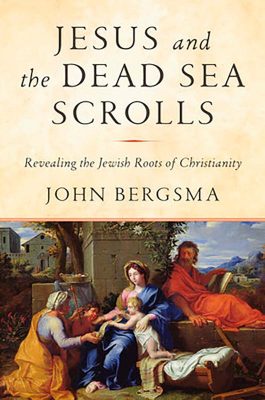By David Gibson
“Jesus and the Dead Sea Scrolls: Revealing the Jewish Roots of Christianity” by John Bergsma. Image Books (New York, 2019). 257 pp., $25.
One of the last acts of the Jewish community that once inhabited Qumran on the Dead Sea’s northwest shore may have been the hiding of its treasured “holy scrolls” in nearby caves upon seeing Roman legions “approaching in the distance.” This happened around the time in 70 C.E. when Rome also destroyed Jerusalem and its temple.
The legions “seem to have ignominiously annihilated” the Qumran community, John Bergsma writes in “Jesus and the Dead Sea Scrolls.” Unwittingly, during the 1946-1947 winter, Bedouin shepherds directed the world’s attention back to Qumran. Searching a cave for hidden treasure, they discovered a jar containing “three old scrolls,” among them a “nearly pristine copy of the Book of Isaiah in Hebrew.”
Finding no gold, the shepherds found something far better. “In the years 1949 to 1956, dozens of exploratory missions … located a total of 11 scroll-bearing caves” near Qumran, says Bergsma. An expert on the scrolls, he is a theology professor at the Franciscan University of Steubenville, Ohio.
I am happy to have read this book. It brought Qumran to life, a community that people today might consider monastic in its faith-centered lifestyle.

The Qumranites were Essenes, Bergsma explains. First-century Jewish culture was dominated by three sects, the Sadducees, Pharisees and Essenes, he observes. While Qumran was an all-male community, Israel’s Essenes also included women.
I always was aware of the presence of Sadducees and Pharisees in the Israel of Jesus’ time, but quite unaware of the Essenes. Yet, Essene communities were present “in all the significant towns and cities of Israel, including Jerusalem,” Bergsma says.
He describes how the Dead Sea Scrolls “give us a window into the thought and practice of the Judaism of Jesus’ day.” The author became convinced the scrolls illuminate many “otherwise confusing or hard to understand” New Testament passages.
For example, he devotes attention to Essenes in Jerusalem and how they may have factored into the time and place of Jesus’ Last Supper and thus help explain a “discrepancy in the date of Passover” that has challenged Scripture scholars.
“Curious features of the Gospel accounts … would be explained if Jesus celebrated the Last Supper in the Essene neighborhood of Jerusalem,” following “the calendar they used,” Bergsma suggests.
“Jesus and the Dead Sea Scrolls” is remarkably readable, considering the seriousness and range of its topic. A concise summary at each chapter’s conclusion clears up any possible confusion about the author’s intent.
I found Bergsma’s discussion of John the Baptist fascinating. I had been wondering if Scripture’s writers treated John the Baptist considerably more seriously than Christianity nowadays often does.
John the Baptist, eating locusts or wearing camel hair garments, appears less eccentric when the beliefs and practices of Qumran are known, Bergsma suggests. “The circumstantial case that John had contact with the Essenes at Qumran is very strong,” he writes.
He asks whether it is “just coincidence” that John the Baptist and the Qumranites were working only a few miles from each other when John’s preaching and baptisms were attracting large crowds in the desert. Bergsma thinks that John and the Qumranites knew each other well.
Bergsma puts forward a scenario that “can’t be proven” but that “does fit with all the known facts” in which John “received some or all of his education” at Qumran. Was he sent there at a young age? Did he voluntarily join Qumran later?
When people asked John how they ought to conduct their lives, he responded: “Whoever has two tunics should share with the person who has none. And whoever has food should do likewise” (Lk 3:11). Bergsma suggests that in this way John “encouraged the ethic of simplicity and equality he had learned at Qumran.”
However, the author appears rather certain that John left Qumran or was expelled, perhaps due to his conviction that “God’s message of salvation should go out to all the people, not just an elite among Israel.” That conviction clashed with Qumranite teaching.
It seems the influence of John the Baptist and his Qumran background extends even further. Bergsma proposes that the sometimes puzzling Gospel of John “makes sense as the work of the apostle John, who was a disciple of John the Baptist before following Jesus.”
“No number of parallels between Christian and Essene literature can explain away the unique and remarkable nature of the person and ministry of Jesus of Nazareth,” Bergsma states. The Essenes were not Christianity’s “‘parent’ movement,” he says. The Qumranites and early Christians were “siblings.”
A benefit of the Dead Sea Scrolls in Bergsma’s eyes is the help they provide in making Christianity’s origins “more understandable in their ancient historical context.”
Gibson was the founding editor of Origins, Catholic News Service’s documentary service. He retired in 2007 after holding that post for 36 years.






















